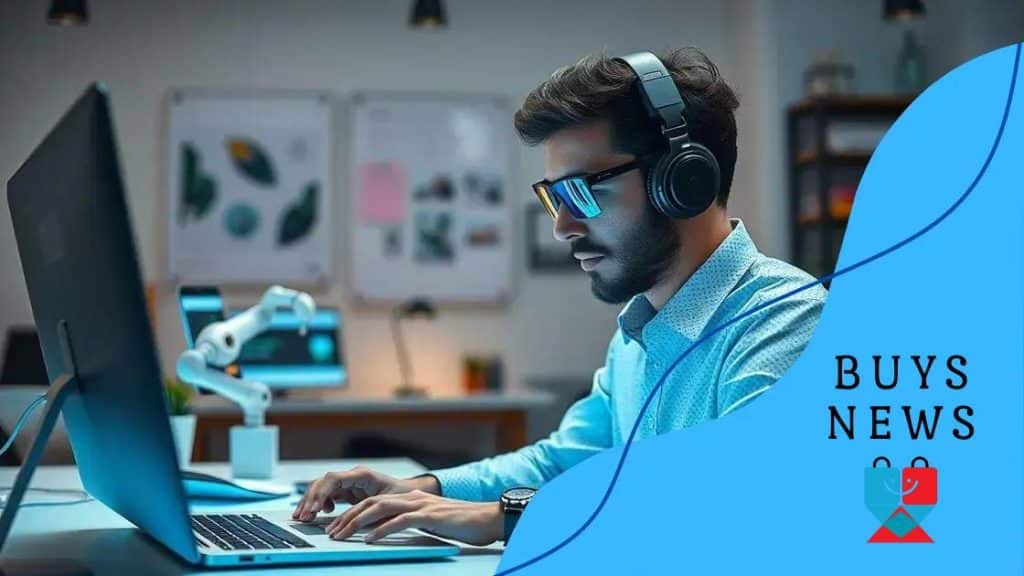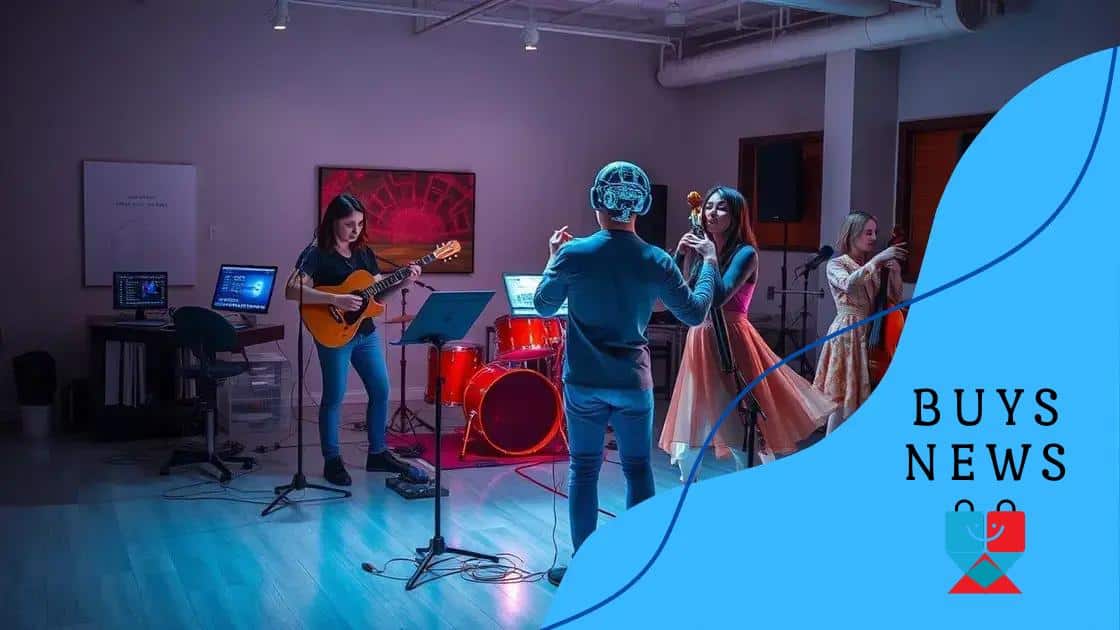The role of AI in transforming the creative industries

The role of AI in transforming the creative industries includes enhancing collaboration, improving efficiency, and sparking innovation, while also raising challenges related to job displacement and ethical considerations.
The role of AI in transforming the creative industries is reshaping how we approach creativity. Imagine a world where AI assists artists and designers, making their workflows smoother and more innovative. This article explores these fascinating changes.
How AI enhances content creation
AI is transforming how we create content, making it faster and more efficient. From writing articles to generating images, AI tools are revolutionizing the creative process.
One of the significant ways AI enhances content creation is through automation. Writers can now use AI to generate ideas, outlines, and even full drafts. This allows them to focus more on refining their work and less on staring at a blank page.
AI Tools for Writers
Various AI tools can assist writers by providing suggestions and correcting grammar. Some popular options include:
- Grammarly: Helps improve writing quality.
- Copy.ai: Generates marketing copy and social media posts.
- Jasper: Produces long-form content based on prompts.
As these tools continue to evolve, we can expect even more capabilities in the future, changing how we think about content creation.
The Role of AI in Visual Content
But AI isn’t just about text. Visual content is being enhanced as well. AI can generate stunning graphics and images tailored to specific needs. For instance, designers can use AI to create logos or artwork in minutes.
This technology not only speeds up the design process but also opens up new avenues for creativity. By analyzing trends and preferences, AI can help creators produce visuals that resonate more with their audience.
Furthermore, filmmakers are integrating AI into their workflows. From editing to special effects, AI streamlines complex tasks, allowing directors and producers to focus on their vision.
In partnerships with human creativity, AI can lead to innovative content that combines the best of both worlds, proving that technology and art can coexist.
The impact of AI on design processes
The impact of AI on design processes is significant and growing. Designers now have powerful tools at their fingertips that help them create everything from graphics to user interfaces.
With AI, repetitive tasks can be automated, allowing designers to focus on creativity and innovation. For instance, many design software programs now use AI to suggest improvements and automate things like color matching.
Benefits of AI in Design
Integrating AI into design processes offers several advantages, such as:
- Speed: AI speeds up tasks, enabling faster project completion.
- Creativity: AI can generate new designs based on input data.
- Efficiency: Tools can streamline workflows by handling repetitive tasks.
AI also analyzes user data to provide insights, ensuring designs meet the needs of their audience. Designers can make informed decisions by understanding what resonates with users, enhancing the overall design process.
AI-Driven Design Tools
Several AI-driven tools are changing the landscape of design. These tools offer unique features that improve the way designers work. A few notable ones include:
- Adobe Sensei: Integrates machine learning into design software to enhance capabilities.
- Canva: Utilizes AI to help users create stunning visuals quickly.
- Figma: Offers features that use AI for design suggestions and layout optimization.
As AI continues to evolve, we can expect more tools and features to emerge. This evolution promises to bring even greater efficiency and creativity to the design world. By embracing AI, designers can focus on what they do best: crafting visually compelling and user-centered designs.
AI in music and performing arts

AI in music and performing arts is changing how artists create and perform. The integration of technology into these fields brings new possibilities and innovations.
In music, AI can compose original pieces by analyzing vast amounts of existing music. This technology helps artists explore new genres and styles they might not have considered before. For instance, AI tools like OpenAI’s MuseNet can create complex compositions that blend different musical traditions.
Applications of AI in Music
Several applications of AI are enhancing the music industry:
- Music Composition: AI can generate melodies and harmonies based on user input and preferences.
- Music Recommendations: Streaming platforms use AI algorithms to suggest songs tailored to individual tastes.
- Sound Engineering: AI helps engineers mix tracks and enhance sound quality efficiently.
This shift allows musicians to focus more on creativity while relying on AI to handle technical tasks. With AI, artists can spend more time perfecting their craft, knowing that technology is streamlining various aspects of music production.
AI in Performing Arts
The realm of performing arts is also benefiting from AI applications. In theater and dance, AI can analyze performances to provide feedback on timing, expression, and movement. Moreover, choreographers can use AI to create original dance routines or explore different interpretations of existing works.
AI-powered tools can assist in set design, helping artists visualize their ideas in real-time. By simulating lighting, staging, and special effects, AI enables designers to make informed decisions that enhance the overall experience for audiences.
As technology evolves, the collaboration between AI and artists will deepen, leading to a future where creativity and technology work hand in hand, expanding the boundaries of music and performing arts.
Challenges AI brings to creatives
The rise of AI in creative fields is not without its challenges. While AI offers numerous benefits, it also presents hurdles that creatives must address.
One significant concern is the fear of job displacement. As AI tools become more proficient at tasks traditionally performed by humans, some worry that their roles may be at risk. This concern is especially prevalent among artists, musicians, and writers, who may feel threatened by AI-generated content.
Ethical Considerations
Another challenge involves ethical implications in the creative process. Questions arise about copyright and ownership of AI-generated works. Who truly owns a piece of art or music created with the help of AI? This debate continues to evolve as more creators integrate AI into their processes.
Moreover, there is a risk of homogenization. When many creators rely on the same AI tools, there’s a chance that the outputs may become too similar, lacking the unique flair that individual artists bring to their work. It’s crucial for creatives to find ways to maintain their distinct voices while embracing technology.
The Learning Curve
Adopting AI tools also involves a learning curve. Many artists may not feel comfortable using complex AI software, which can lead to frustration. Education and support are essential to help creatives navigate this transition effectively.
Additionally, there’s a concern about over-reliance on AI to generate ideas or content. While AI can provide inspiration, relying too heavily on it may hinder original thought and creativity.
Addressing these challenges is vital for the future of AI in creative fields. By navigating the complexities of ethics, skill-building, and maintaining originality, creatives can harness AI’s potential while preserving their unique artistic identities.
The future of AI in creativity
The future of AI in creativity holds exciting possibilities. As technology advances, we can expect AI to play an even larger role in how we create art, music, and design.
One main area of development is the collaboration between AI and humans. Rather than replacing artists, AI can enhance their capabilities. For instance, it can assist in brainstorming ideas or generating drafts that creatives can refine and personalize. This collaboration encourages new forms of artistic expression.
Emerging AI Tools
New AI tools are continuing to emerge, making creative processes more efficient. These tools are designed to adapt to the user’s style and preferences, leading to more personalized results. Some examples include:
- AI Generators: Programs that create images or music based on user prompts.
- Smart Editing Software: Tools that can automatically improve images or audio files.
- Collaborative Platforms: Spaces where artists can work alongside AI, using it as a brainstorming partner.
As these tools become more sophisticated, they will open doors to innovative creations that blend human creativity with technological capabilities.
Ethical and Social Implications
The evolution of AI in creativity also brings important ethical and social implications. Discussions about copyright, authorship, and authenticity will become more prominent. Artists and technologists must navigate these concerns to ensure fair use of AI-generated content.
Additionally, as AI reshapes creative industries, educators may need to adjust their curricula. Teaching future artists and designers how to effectively use AI tools will be crucial for preparing them for the changing landscape. The combination of art and technology will be essential for tomorrow’s creatives.
In summary, the future of AI in creativity is bright and filled with potential. By harnessing AI’s strengths, artists can explore uncharted territories and redefine what is possible in their work.
FAQ – Frequently Asked Questions about AI in Creative Industries
How does AI help enhance creative processes?
AI assists artists by automating repetitive tasks, generating ideas, and providing tools that boost creativity, allowing them to focus on their craft.
What challenges does AI bring to creatives?
AI introduces concerns such as job displacement, ethical issues regarding copyright, and the potential for homogenization in artistic outputs.
What is the future outlook for AI in creativity?
The future holds exciting potential for AI to create new creative landscapes, enhancing collaboration between artists and technology.
How can artists maintain their unique voices with AI?
Artists can combine their originality with AI capabilities, ensuring their work remains distinctive while using technology as a supportive tool.





